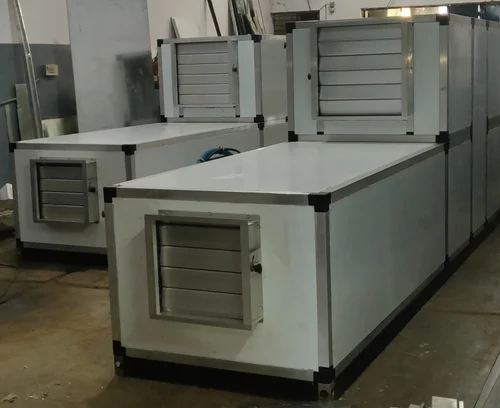Air handling units, AHUs, indoor air quality as well as good ventilation, become important in many cases. AHUs control and distribute air in the buildings and so play an important part in commercial, industrial, and residential applications. The selection of an effective Air Handling Unit would have a huge effect on energy efficiency, comfort, and air quality. In this guide, we get into the details of the different types of Air Handling systems, helping you make the best choice for your building.

What is an Air Handling Unit (AHU)?
The central part of the HVAC system includes an AHU unit. An AHU consists of filters, fans, heating/cooling coils, dampers, and controls used to condition and circulate air within the building. Depending on one's needs, AHUs can vary in size, design, and way function.
Types of Air Handling Units
There are four primary types of air handling systems, each one is designed for specific uses. Knowing their characteristics and benefits will help you choose the perfect AHU as per your uses.
1. Ceiling Suspended Type AHU
Ideal for: Limited floor space installations with the need for compact units.
Major Features:
- Installed on the ceiling, freeing up valuable floor space.
- Best suited for offices, retail environments, and restaurants.
- Fitted with high-tech insulation to keep noise levels low.
- Generally light in weight and made for simplicity of installation.
Advantages:
- Provides quiet running for noise-prone areas.
- Delivers efficient airflow control for small spaces.
- Eliminates clutter in spaces with limited floor space, beautifying the room.
- Needs less maintenance as the parts are accessible from the bottom.
2. Vertical Type AHU
Best for: Spaces with height limitations or restricted horizontal space.
Key Features:
- Mounted in a vertical position to achieve maximum space utilization.
- Ideal for utility rooms, factories, and commercial environments.
- Typically features modular configurations that can be easily upgraded or expanded.
- Space-saving footprint guarantees improved space use in congested mechanical rooms.
Advantages:
- Uses very little floor space, which makes it suitable for cramped spaces.
- Achieves efficient air distribution for narrow and tall spaces.
- Simple to service and maintain with access points built for rapid inspection.
- Increased efficiency with high-speed fans and maximized airflow channels.
3. Horizontal Type AHU
Ideal for: Spacious, open rooms with enough floor space.
Critical Features:
- Built horizontally to promote simple accessibility for components.
- Standard in use with data centers, warehouses, and manufacturing facilities.
- Tended to be constructed out of heavy-gauge materials in high-uptime applications.
- Preferable to areas with an ample demand for conditioned air flow.
Advantages:
- Easy servicing with unrestricted interior part accessibility.
- Promotes more even air circulation in large open areas.
- Providing better flexibilities to coordinate with duct runs.
- Ideal for applications requiring air mixing chambers for optimal temperature control.
4. TFA (Special Air Treatment Unit)
Best suited for: Environments with high demands on superior air quality and increased filtration.
Key Features:
- Fitted with advanced air conditioning and filtration technologies.
- Widely employed in hospitals, laboratories, and pharmaceutical sectors.
- Made with strong dehumidification systems to control precise humidity levels.
- Engineered to improve indoor air quality by removing dust, allergens, and pollutants.
Advantages:
- Ensures superior indoor air quality controls, especially with high demands on hygiene standards.
- Efficiently removes airborne contaminants, ensuring better and healthier indoor conditions.
- Includes energy-efficient functionalities like heat recovery wheels to save energy.
- Conserves air pressure and airflow consistent levels to maintain a stable operating environment for critical equipment or operations.
Selecting the Proper AHU for Your Requirements
To buy the proper AHU unit for your facility, take these following things into consideration:
- Space and Size Requirements: Assess the space available for installation and the air volume needed.
- Air Quality Requirements: If filtration of the air or control of humidity is important, select units with high-quality filters and humidification capabilities.
- Energy Efficiency: Installing energy-efficient air handlers shall reduce the operating cost and give an edge to sustainability.
- Noise Control: For noise-sensitive applications like offices or homes, select AHUs with sound-absorbing capabilities.
- Maintenance and Accessibility: Opt for systems that are easy to maintain and provide easy access for servicing.
Maintenance Tips for AHUs
To ensure your air handling systems operate at peak efficiency, observe the following maintenance tips:
- Regularly clean and inspect filters to ensure maximum airflow.
- Inspect fan motors and belts for wear.
- Clean heat exchangers and coils to enhance thermal efficiency.
- Inspect controls and sensors to ensure proper system operation.
- Schedule professional maintenance to detect and correct potential problems.
Conclusion
Choosing the right air handling unit will work to ensure maximize proper ventilation, securing a high IAQ level and optimizing energy usage. Depending on whether you require a small fresh air handling unit to add quality and quantity to the indoor air or a patented TFA unit for better filtering, your knowledge of the volume of space and performance of the system will guide you to a true solution. Investment in a proper air handling system ensures the health of the environments for the building occupants and guarantees their comfort; thus, it is a key element in modern HVAC design.

